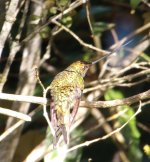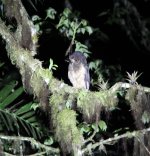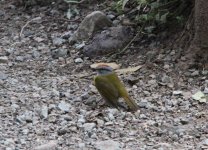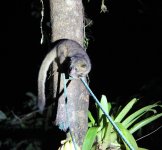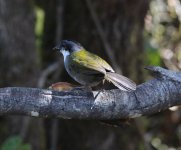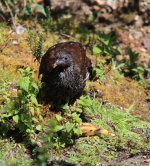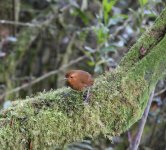Mysticete
Well-known member

Having just returned from Ecuador yesterday, about time for me to put together a trip report!
First, to set things up, NW Ecuador has always been very high on my wishlist of Neotropical birding destinations. For years I have read the tour reports of Tropical Birding and fantasized about Antpittas, Cock-of-the-Rocks, and Tanagers. In a relatively small area, you have a high density of really good and iconic Neotropical and Andean birds, and the elevational gradients mean and assortment of different environments to bird in. Ultimately, for my first trip to the Neotropics, Panama won out, which I visited in 2021. I would stand by my declaration that Panama is the best introduction to birds of this biogeographic region, as the diversity is a little more manageable. But having returned from NW Ecuador I can heartily recommend this as a follow-up visit.
For a long-time I had planned to visit with a tour company, but rising prices ultimately led me to consider booking a private guide, Nelson Apolo Jaramillo. Everyone has different approaches to birding, but my neurotic tendencies mean I can have a much more enjoyable trip if I leave the logistics of driving and such to a local. Plus with the density of new birds on offer, and my own general crappy hearing, I would never have managed to see as much by myself as with a guide. Besides, a local guide gives you access to all sorts of local intel you might not otherwise have.
Nelson has previously guided for other Birdforum members. Lgonz1008 used his services last year, and you can read his report here: Mindo: Birding the West Slope of Ecuador . Nelson is one of the top ebirders in the country, with a fantastic ear, and is brilliant on finding and showing even the skulkiest birds to visitors.
The other perks of getting my own guide versus going with a larger group is that I could focus the trip on what I precisely wanted to see. In this case, this meant going for Oilbird, one of my most wanted birds since I was a kid and reading about it via its animal card. I also made a special effort for Olinguito, a fluffy Olingo relative only described in the last couple of decades, and which reliably can be seen at Bellavista Cloud Forest Lodge.
Ultimately I booked a 7 day trip. I would fly into Quito in the afternoon, then hit the west slope for 5 days. Following this, I would spend a day up at the high elevation sites of Antisana and Papallacta Pass, with one night and morning at Guango. I modeled the trip after the Tropical birding Andes Introtour itinerary, swapping in cheaper lodgings and a side-trip to the Oilbird. This was a fast paced trip and honestly in hindsight maybe I should have cut out the last two days of travel for more days on the West Slope. Doing that I would have probably had more flexibility and might have been able to avoid some misses, although might have still ended up with a smaller overall list. It resulted in a lot of time in the vehicle and made for some rewarding but EXHAUSTING birding.
I chose to travel in June, for two main reasons. First and foremost...I am a university professor. So I am limited to basically January and the summer months for any sort of birding travel. Nelson had a opening in the middle of June which also worked with booking. There are pluses and minuses to traveling to Ecuador at this time of year. On the plus side, there is a lot of fruit available in the forest, which makes quetzals and toucans especially common. I can confirm this, as several species of these birds that seem to provide trouble for people required practically no effort on our part. The downside is...that there is a lot of fruit available in the forest. This means tanagers are not so readily abundant at feeding stations, and indeed tanagers were a group that I felt we struggled with more than we should have, missing or nearly missing several species I considered pretty straightforward to see. Weather also is a factor. This is the dry season, which meant that other than on the east slope, we generally had really good weather the entire trip. As it turns out probably too good, as the warm and sunny weather reduced activity at some key sites, leading to some misses.
If you do a itinerary similar to this, also be prepared to pack a wide range of clothes. At Antisana the weather was chilly, making a jacket and gloves required. While in the lowlands it was hot and humid, requiring a different set of cloths. I brought a rain jacket but the high humidity meant I never wore it; I did use an umbrella at Guango Lodge though, which gets a lot of precipitation. Sunscreen is a must have due to elevation, and bug spray was useful, although honestly I have had worst experiences in Wisconsin in summer than in Ecuador on that front. If you even have the slightest chance of getting motion sick, pack Dramamine. There are no shortage of winding and sometimes bumpy mountain road, and make sure you go with full strength! The guide had a spotting scope so I felt no need to pack my own.
This is getting long so I will post references in the next post.
First, to set things up, NW Ecuador has always been very high on my wishlist of Neotropical birding destinations. For years I have read the tour reports of Tropical Birding and fantasized about Antpittas, Cock-of-the-Rocks, and Tanagers. In a relatively small area, you have a high density of really good and iconic Neotropical and Andean birds, and the elevational gradients mean and assortment of different environments to bird in. Ultimately, for my first trip to the Neotropics, Panama won out, which I visited in 2021. I would stand by my declaration that Panama is the best introduction to birds of this biogeographic region, as the diversity is a little more manageable. But having returned from NW Ecuador I can heartily recommend this as a follow-up visit.
For a long-time I had planned to visit with a tour company, but rising prices ultimately led me to consider booking a private guide, Nelson Apolo Jaramillo. Everyone has different approaches to birding, but my neurotic tendencies mean I can have a much more enjoyable trip if I leave the logistics of driving and such to a local. Plus with the density of new birds on offer, and my own general crappy hearing, I would never have managed to see as much by myself as with a guide. Besides, a local guide gives you access to all sorts of local intel you might not otherwise have.
Nelson has previously guided for other Birdforum members. Lgonz1008 used his services last year, and you can read his report here: Mindo: Birding the West Slope of Ecuador . Nelson is one of the top ebirders in the country, with a fantastic ear, and is brilliant on finding and showing even the skulkiest birds to visitors.
The other perks of getting my own guide versus going with a larger group is that I could focus the trip on what I precisely wanted to see. In this case, this meant going for Oilbird, one of my most wanted birds since I was a kid and reading about it via its animal card. I also made a special effort for Olinguito, a fluffy Olingo relative only described in the last couple of decades, and which reliably can be seen at Bellavista Cloud Forest Lodge.
Ultimately I booked a 7 day trip. I would fly into Quito in the afternoon, then hit the west slope for 5 days. Following this, I would spend a day up at the high elevation sites of Antisana and Papallacta Pass, with one night and morning at Guango. I modeled the trip after the Tropical birding Andes Introtour itinerary, swapping in cheaper lodgings and a side-trip to the Oilbird. This was a fast paced trip and honestly in hindsight maybe I should have cut out the last two days of travel for more days on the West Slope. Doing that I would have probably had more flexibility and might have been able to avoid some misses, although might have still ended up with a smaller overall list. It resulted in a lot of time in the vehicle and made for some rewarding but EXHAUSTING birding.
I chose to travel in June, for two main reasons. First and foremost...I am a university professor. So I am limited to basically January and the summer months for any sort of birding travel. Nelson had a opening in the middle of June which also worked with booking. There are pluses and minuses to traveling to Ecuador at this time of year. On the plus side, there is a lot of fruit available in the forest, which makes quetzals and toucans especially common. I can confirm this, as several species of these birds that seem to provide trouble for people required practically no effort on our part. The downside is...that there is a lot of fruit available in the forest. This means tanagers are not so readily abundant at feeding stations, and indeed tanagers were a group that I felt we struggled with more than we should have, missing or nearly missing several species I considered pretty straightforward to see. Weather also is a factor. This is the dry season, which meant that other than on the east slope, we generally had really good weather the entire trip. As it turns out probably too good, as the warm and sunny weather reduced activity at some key sites, leading to some misses.
If you do a itinerary similar to this, also be prepared to pack a wide range of clothes. At Antisana the weather was chilly, making a jacket and gloves required. While in the lowlands it was hot and humid, requiring a different set of cloths. I brought a rain jacket but the high humidity meant I never wore it; I did use an umbrella at Guango Lodge though, which gets a lot of precipitation. Sunscreen is a must have due to elevation, and bug spray was useful, although honestly I have had worst experiences in Wisconsin in summer than in Ecuador on that front. If you even have the slightest chance of getting motion sick, pack Dramamine. There are no shortage of winding and sometimes bumpy mountain road, and make sure you go with full strength! The guide had a spotting scope so I felt no need to pack my own.
This is getting long so I will post references in the next post.





